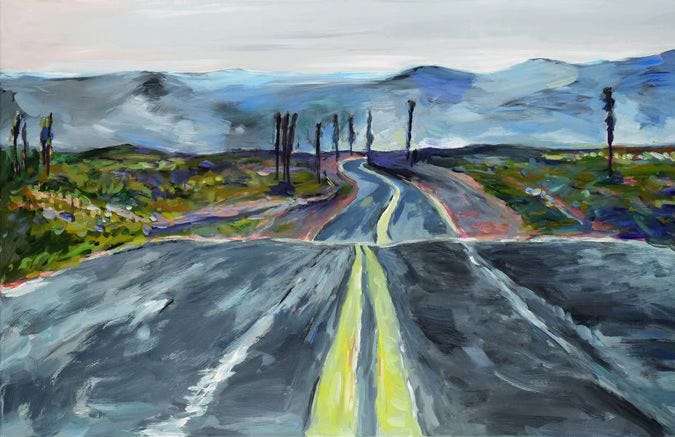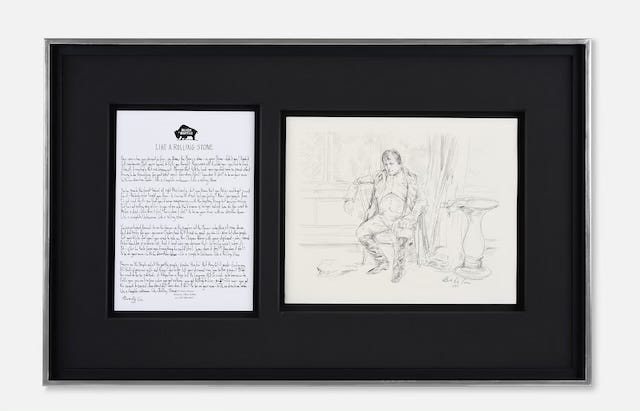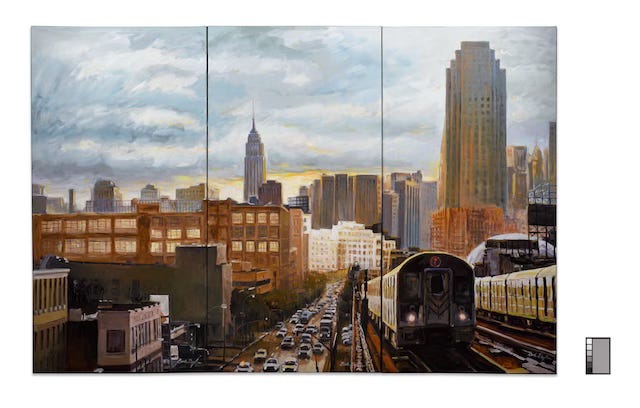He’s Got Everything He Needs, He’s an Artist, He Don’t Look Back
Best known as a Nobel Prize-winning songwriter, Bob Dylan is also an accomplished visual artist working in a variety of modes
On the occasion of his 83rd birthday, I wanted to revisit an article I wrote two years ago about a retrospective of Bob Dylan’s visual artworks. -- SR
DOES BOB DYLAN WRITE HIS SONGS in black and white or in color?
This is just one question of many that occur to a viewer after spending a few hours with the 200-odd visual artworks that comprise “Bob Dylan Retrospectrum,” which I saw on exhibit in April 2022, at the Patricia & Phillip Frost Art Museum on the campus of Florida International University in Miami.
One reason to wonder about the color of his songs is that as a painter, Dylan mostly favors a bright, colorful palette. One might even call it technicolor.
Sure, Dylan the visual artist also works in black and white. He sketches in pencil, he makes elaborate line drawings, and he conjures illustrations that suggest he could have had an alternate career drawing interstitials for the New Yorker.
But wait, you say. Since when is Bob Dylan is a visual artist?
WE HAVE ALWAYS KNOWN THAT Dylan dabbled in artwork. Occasional drawings accompanied his hand-penned liner notes and full-fledged paintings appeared as cover art for the Band’s 1968 debut album, Music from Big Pink, and his own 1970 album, Self Portrait, the cover of which was, aptly, a self-portrait by Bob Dylan. (Most of the songs on that album, however, were not Bob Dylan compositions – that was the joke.) In 1973, Writings and Drawings was published by Knopf, containing lyrics from all his songs up until that time alongside illustrations never before seen, some of which are included in the Retrospectrum exhibition.
It has also been no secret that in early 1974, Dylan took a series of art classes with the Manhattan-based painter Norman Raeben. Dylan famously told interviewers years later that Raeben had not only taught him to paint but had altered his outlook on life to such an extent that his wife, Sara, no longer understood him. (Incidentally, Raeben’s family name was originally Rabinovich, as in Solomon Rabinovich, known better to all as Sholem Aleichem, the Yiddish writer and Raeben’s father.)
IN MORE RECENT YEARS, there have been various small gallery exhibitions of Dylan’s artwork, mostly in Europe and Asia. The “Retrospectrum” exhibition brings together many of the gallery exhibitions into one comprehensive museum-size display of his works. It made its world premiere at the Modern Art Museum in Shanghai in 2019, where it included even more individual artworks, although the current show at the Frost Museum contains more recent works. It turns out Bob Dylan was a busy guy for the two years that the pandemic kept him off the road, where he had been performing 100 concerts a year on average for the past 35 years or so. While the rest of us were sitting around streaming classic films on the Criterion Channel, Dylan was intermittently hitting pause on the remote, capturing an image, and turning it into a painting, about two dozen of which are seen here for the first time as part of the “Deep Focus” series.
The “Deep Focus” series shares narrative concerns from Dylan’s earlier “Beaten Path” series of paintings, filled with scenes of Americana presumably inspired by his never-ending criss-crossing of the U.S. year after year. Dylan renders cheap motels, trains, bars, roadside food joints, liquor stores, and old-time soda fountains in bright colors. Stylistic tics first seen in his “Drawn Blank” series of paintings from 1989-1992 are given full range here and carry forward to the “Deep Focus” paintings. Dylan’s skies are more often red than blue. His shapes are bold but the outlines are slightly blurred, giving the images a sense of energy and motion. The images, even if they are a still life, are therefore rarely static but invested with an internal spirit. Dylan did not invent this technique, of course. His painterly influences are wide-ranging, with equal doses of French Impressionism and German Expressionism mixed in with Surrealism, Cubism, Rube Goldberg, and an overall aesthetic borrowed from film noir. Just as with his songs, which draw variously from Shakespeare, the Bible, the Beat poets, Japanese crime fiction, and movie dialogue, Dylan recombines his visual sources so that what comes out in the end are these visions of Bob Dylan.
The “Beaten Path” series includes “Guthrie’s Alley,” a cocktail lounge in Bakersfield, in an apt nod to Dylan’s early hero and role model, Woody Guthrie. It includes scenes of Coney Island along with city streets and subway stations. Most of the paintings have a ghostly quality, the vast majority of them unpopulated by human beings. In that sense, they could be visions of a dystopic landscape or of end times. It is only when Dylan turns to replicating film stills that his paintings include people, but even then, they are overwhelmed by the mises en scène, to apply a film term to painting, which seems only right in this instance.
The exhibition also includes samples from Dylan’s “Mondo Scripto” series, in which handwritten song lyrics – often revised from their original versions – are paired with pencil drawings that literally or figuratively relate to the songs. Thus, “Subterranean Homesick Blues” shows a man in the kitchen of a basement apartment whisking something in a pot; we infer that it shows “Johnny’s in the basement mixing up the medicine.” The lyrics to “Like a Rolling Stone” are paired with a stately drawing of Napoleon Bonaparte – “Napoleon in rags” as the song goes. “A Hard Rain’s a-Gonna Fall” is portrayed as a storm whipping up waves that are flooding the streets of Manhattan, and the “ancient empty street’s too dead for dreaming” in “Mr. Tambourine Man” is represented by a Roman road paved with cobblestones, with pillars in front of crumbling buildings and no people to be seen.
The exhibition also includes a sampling of Dylan’s sculptures cast from iron. These ironworks are a nod to Dylan’s childhood home in Hibbing, Minn., a town literally built by the mining company that owned a nearby open pit said to be the world’s largest and to have provided the majority of the raw materials forged into armaments during the first World War. Most of Robert “Bobby” Zimmerman’s friends’ fathers worked in the pit and shopped at his family’s downtown appliance store. Dylan has beaten the swords into plowshares, so to speak, constructing gates, tables, and wall hangings from pre-existing industrial pullies, springs, horseshoes, flywheels, gears, chains, hand tools, vise grips, etc., all stamped with his trademark “Black Buffalo Ironworks” signature. Does Dylan’s imagination know no bounds?
A highlight of the monumental exhibition is the aptly titled monumental triptych called “Sunset, Monument Valley.” The upper half of the painting portrays the stunning natural feature in Arizona, rendered in heavenly oranges and yellows. In the foreground is a 1960 Chevy Impala, dwarfed by the range and headed toward the mountain pass on a two-lane highway into a sunset that seems nothing less than the image of a fiery, blinding God on Mount Sinai. It is just one of many paintings with highways and train tracks running through the center of the frame, in various states of curvatures and abstraction. Dylan has painted a whole series of numbered scenes called “Endless Highway,” which, rendered from the point of view of someone driving a car, capture the promise of the open road as a symbol of American freedom. But again, without any people in the frame, the paintings also bear a sense of loss or of promise betrayed – as well as a nod to a song by the same title recorded by the Band, his one-time backing group.
I LIKE TO SAY THAT DYLAN HAS NEVER – or almost never – written or sung a blues song. While he has very obviously absorbed the blues form, the blues vernacular, the blues attitude, and blues tropes, in the end, Bob Dylan’s blues are first and foremost Bob Dylan songs. Casual listeners may think they are hearing a blues song or a blues singer, but that is the magic and the genius – Dylan transubstantiates the blues into Bob Dylan music.
The same goes for his visual art. No matter what the influence or source material, whether he is painting a scene drawn from a film or a photograph or even a postcard, Dylan puts his paintings, drawings, and sculptures through the Bob Dylan grinder. What comes out is quintessential Dylan -- which includes a respect for tradition, an altered perspective, a sense of humor, and a unique, fractured vision.
Back in 1971, Dylan recorded a song called “When I Paint My Masterpiece,” which invoked ancient Rome, Botticelli, Brussels, and “a picture of an old oak tree by my side.” While Dylan will always be known best for his much-lauded songwriting, for which his Nobel Prize for Literature is only one of what could be a gallery full of prizes and honors and lifetime achievement awards, it turns out that he has also, literally, painted his masterpiece – several times over.
This article was originally published in The Forward on March 23, 2022.
Hey, did you like this edition of Everything Is Broken? If so, please consider clicking on the “LIKE” button at the very end of this message. It matters to the gods of Substack.
Roll Call: Founding Members
Anne Fredericks
Anonymous (7)
Erik Bruun
Nadine Habousha Cohen
Fred Collins
Fluffforager
Benno Friedman
Amy and Howard Friedner
Jackie and Larry Horn
Richard Koplin
Paul Paradiso
Steve and Helice Picheny
David Rubman
Spencertown Academy Arts Center
Elisa Spungen and Rob Bildner/Berkshires Farm Table Cookbook
Julie Abraham Stone
Mary Herr Tally








Very cool. Glad you could mention the sculptures. Been following Dylan and a big fan since I was just a boy. Like many of us, I am sure. Wonderful review. Thank you, Seth.
If you care at all, here is piece of mine of the bard --
https://judsonvereen.substack.com/p/bob-dylan-cant-sing